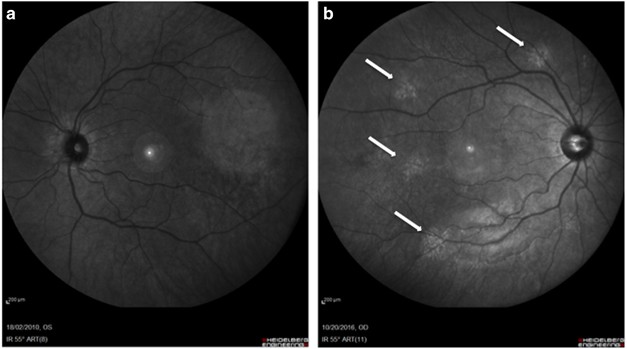doi.org/10.1038/jhg.2017.78
Preview meta tags from the doi.org website.
Linked Hostnames
24- 72 links todoi.org
- 24 links towww.nature.com
- 16 links toscholar.google.com
- 14 links toscholar.google.co.uk
- 14 links towww.ncbi.nlm.nih.gov
- 6 links towww.springernature.com
- 4 links topartnerships.nature.com
- 3 links toauthorservices.springernature.com
Thumbnail

Search Engine Appearance
The absence that makes the difference: choroidal abnormalities in Legius syndrome - Journal of Human Genetics
Neurofibromatosis type 1 (NF1) is an hereditary disorder characterized by abnormal proliferation of multiple tissues of neural crest origin, and presents mainly with multiple café-au-lait macules, axillary freckling and neurofibromas. Choroidal involvement in NF1 patients has been studied, thanks to the development of non-invasive tools such as infrared monochromatic light during fundus examination, which showed bright patchy lesions consistent with choroidal nodules. Choroidal abnormalities identified with near-infrared reflectance have reported with a frequency of up to 100% in NF1, and have been recently been proposed as a novel diagnostic criterion for NF1. Legius syndrome can be clinically indistinguishable from NF1 and results in a small percentage of individuals being misdiagnosed. We investigated the presence of choroidal abnormalities in Legius syndrome to determine their specificity to NF1 and their potential usefulness as a novel diagnostic criterion for NF1. We examined the fundus of 16 eyes by confocal scanning laser ophthalmoscopy with infrared monochromatic light in eight patients with molecularly confirmed Legius syndrome. No abnormalities were observed, confirming the diagnostic value of choroidal abnormalities for the diagnosis of NF1.
Bing
The absence that makes the difference: choroidal abnormalities in Legius syndrome - Journal of Human Genetics
Neurofibromatosis type 1 (NF1) is an hereditary disorder characterized by abnormal proliferation of multiple tissues of neural crest origin, and presents mainly with multiple café-au-lait macules, axillary freckling and neurofibromas. Choroidal involvement in NF1 patients has been studied, thanks to the development of non-invasive tools such as infrared monochromatic light during fundus examination, which showed bright patchy lesions consistent with choroidal nodules. Choroidal abnormalities identified with near-infrared reflectance have reported with a frequency of up to 100% in NF1, and have been recently been proposed as a novel diagnostic criterion for NF1. Legius syndrome can be clinically indistinguishable from NF1 and results in a small percentage of individuals being misdiagnosed. We investigated the presence of choroidal abnormalities in Legius syndrome to determine their specificity to NF1 and their potential usefulness as a novel diagnostic criterion for NF1. We examined the fundus of 16 eyes by confocal scanning laser ophthalmoscopy with infrared monochromatic light in eight patients with molecularly confirmed Legius syndrome. No abnormalities were observed, confirming the diagnostic value of choroidal abnormalities for the diagnosis of NF1.
DuckDuckGo
The absence that makes the difference: choroidal abnormalities in Legius syndrome - Journal of Human Genetics
Neurofibromatosis type 1 (NF1) is an hereditary disorder characterized by abnormal proliferation of multiple tissues of neural crest origin, and presents mainly with multiple café-au-lait macules, axillary freckling and neurofibromas. Choroidal involvement in NF1 patients has been studied, thanks to the development of non-invasive tools such as infrared monochromatic light during fundus examination, which showed bright patchy lesions consistent with choroidal nodules. Choroidal abnormalities identified with near-infrared reflectance have reported with a frequency of up to 100% in NF1, and have been recently been proposed as a novel diagnostic criterion for NF1. Legius syndrome can be clinically indistinguishable from NF1 and results in a small percentage of individuals being misdiagnosed. We investigated the presence of choroidal abnormalities in Legius syndrome to determine their specificity to NF1 and their potential usefulness as a novel diagnostic criterion for NF1. We examined the fundus of 16 eyes by confocal scanning laser ophthalmoscopy with infrared monochromatic light in eight patients with molecularly confirmed Legius syndrome. No abnormalities were observed, confirming the diagnostic value of choroidal abnormalities for the diagnosis of NF1.
General Meta Tags
121- titleThe absence that makes the difference: choroidal abnormalities in Legius syndrome | Journal of Human Genetics
- X-UA-CompatibleIE=edge
- applicable-devicepc,mobile
- viewportwidth=device-width,initial-scale=1.0,maximum-scale=5,user-scalable=yes
- 360-site-verification5a2dc4ab3fcb9b0393241ffbbb490480
Open Graph Meta Tags
5- og:urlhttps://www.nature.com/articles/jhg201778
- og:typearticle
- og:site_nameNature
- og:titleThe absence that makes the difference: choroidal abnormalities in Legius syndrome - Journal of Human Genetics
- og:imagehttps://media.springernature.com/m685/springer-static/image/art%3A10.1038%2Fjhg.2017.78/MediaObjects/10038_2017_Article_BFjhg201778_Fig1_HTML.jpg
Twitter Meta Tags
6- twitter:site@null
- twitter:cardsummary_large_image
- twitter:image:altContent cover image
- twitter:titleThe absence that makes the difference: choroidal abnormalities in Legius syndrome
- twitter:descriptionJournal of Human Genetics - The absence that makes the difference: choroidal abnormalities in Legius syndrome
Item Prop Meta Tags
5- position1
- position2
- position3
- position4
- publisherSpringer Nature
Link Tags
15- alternatehttps://www.nature.com/jhg.rss
- apple-touch-icon/static/images/favicons/nature/apple-touch-icon-f39cb19454.png
- canonicalhttps://www.nature.com/articles/jhg201778
- icon/static/images/favicons/nature/favicon-48x48-b52890008c.png
- icon/static/images/favicons/nature/favicon-32x32-3fe59ece92.png
Emails
1Links
171- http://scholar.google.com/scholar_lookup?&title=Choroidal%20abnormalities%20detected%20by%20near-infrared%20reflectance%20imaging%20as%20a%20new%20diagnostic%20criterion%20for%20neurofibromatosis%201&journal=Ophthalmology&doi=10.1016%2Fj.ophtha.2011.07.046&volume=119&pages=369-375&publication_year=2012&author=Viola%2CF&author=Villani%2CE&author=Natacci%2CF&author=Selicorni%2CA&author=Melloni%2CG&author=Vezzola%2CD
- http://scholar.google.com/scholar_lookup?&title=Choroidal%20abnormalities%20in%20caf%C3%A9-au-lait%20syndromes%3A%20a%20new%20differential%20diagnostic%20tool%3F&journal=Clin.%20Genet.&doi=10.1111%2Fcge.12873&volume=91&pages=529-535&publication_year=2017&author=Cassiman%2CC&author=Casteels%2CI&author=Jacob%2CJ&author=Plasschaert%2CE&author=Brems%2CH&author=Dubron%2CK
- http://scholar.google.com/scholar_lookup?&title=Choroidal%20abnormalities%20in%20neurofibromatosis%20type%201%20detected%20by%20near-infrared%20reflectance%20imaging%20in%20paediatric%20population&journal=Acta%20Ophthalmol.&doi=10.1111%2Faos.12750&volume=93&pages=e667-e671&publication_year=2015&author=Vagge%2CA&author=Camicione%2CP&author=Capris%2CC&author=Sburlati%2CC&author=Panarello%2CS&author=Calevo%2CMG
- http://scholar.google.com/scholar_lookup?&title=Diagnostic%20value%20of%20the%20caf%C3%A9-au-lait%20spot%20in%20children&journal=Arch.%20Dis.%20Child&doi=10.1136%2Fadc.41.217.316&volume=41&pages=316-319&publication_year=1966&author=Whitehouse%2CD
- http://scholar.google.com/scholar_lookup?&title=Frequency%20of%20choroidal%20abnormalities%20in%20neurofibromatosis%20type%201&journal=Lancet&doi=10.1016%2FS0140-6736%2800%2902716-1&volume=356&pages=988-992&publication_year=2000&author=Yasunari%2CT&author=Shiraki%2CK&author=Hattori%2CH&author=Miki%2CT